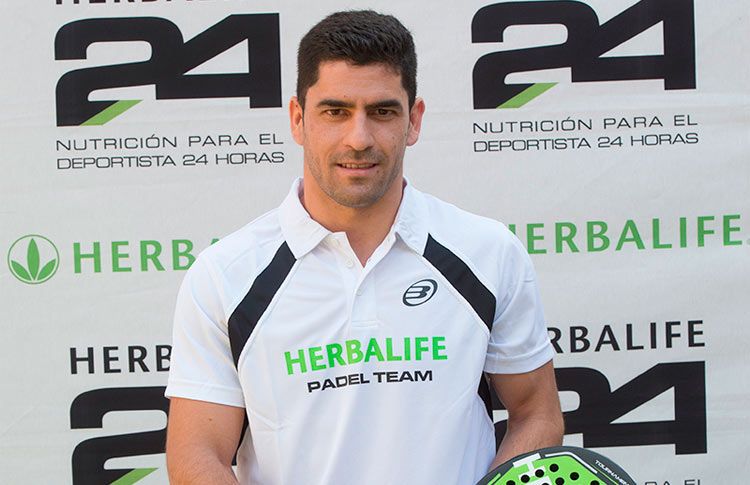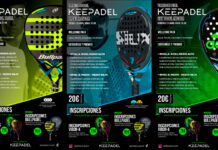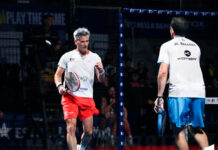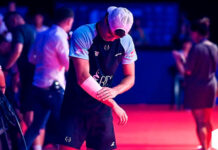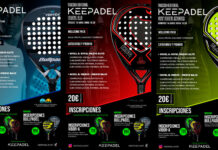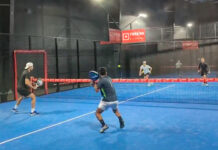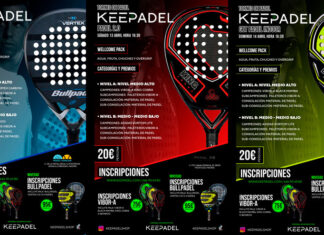A dialogue between Julián Álvarez, Doctor Specialist in Sports Medicine and Member of the Nutritional Advisory Board of Herbalife Internacional and the members of the Herbalife Pádel Team, Eli Amatriain and Maxi Sánchez, before his next sporting challenge: the Estrella Damm Final Master 2016.
Padel World Press .- Do not miss this original and interesting conversation, in which we can learn more about the preparation routines of two of the best players in the world.
Julián Álvarez
As big players of padel that you are, you prepare the games conscientiously. In this sport, as in all, not only is it important to know the rules of the game but also to prepare the sports, physical and nutritional strategy, as well as to study the environment and rivals. Until then, I do not discover anything new, but do you know how to face such a challenge and physical and mental effort from the point of view of hydration and nutrition?
Eli Amatriain
No (laughs), in fact one of the points that I value the most about the collaboration with Herbalife is the nutritional support we receive. I am beginning to understand that, without adequate nutrition aimed at maximum sporting performance, we are like birds without wings ... We lack something to fly high! (laughs)
Maxi Sánchez
The Herbalife-24 line, aimed at the athlete's diet, helps and complements us a lot in our day to day. In that sense, we feel quite aligned with our nutritional objectives. However Julian, as you know, we will soon face very tough and demanding tests of our sports calendar, how should we face them? What advice could you give us? We want to win!
Julián Álvarez
And I have no doubt you will, guys! You are doing a fantastic job these seasons but yes, I can give you some tips aimed at optimizing your nutritional strategies. Are you ready? There they go.
As you know, padel is an interválico sport, that is, in which high intensity actions are combined with continuous stops, such as between point and point or between game and game. As we go up the level, the points become more intense, longer, and the relationship with breaks is less favorable. That is where we begin to realize that we need to have a good aerobic base. If we also take into account that these intense efforts can become an extra load for the locomotor system (bones, joints, muscles or tendons can be seen overloaded), a good physical and nutritional preparation is essential.
- Adapt your meals
We need gasoline to perform in the game, therefore, the first thing we have to do is adapt our meals in terms of the caloric distribution of them in terms of our energy demands. This does not require a great 'precision', that is, exact calculations or adjusted to the minimum detail, but a bit of common sense in terms of a food organization that allows us to get to the track without being in hypoglycemia by fasting, that would condition a limitation to the effort, nor doing the digestion, that could also be an inconvenience, even more severe, for this type of exercise.
Therefore, the first point is to get to the track by marking a 'distance' of, approximately, between 2 and 4 hours with last meal, depending on each one and the volume and composition of said food. We would leave at four hours (again, always referring to average times, then it is important to individualize and that is given to us by experience) when it comes to an important meal (generally more than 1000 cal.) And with a greater load of fats and / or proteins that are difficult to digest (generally protein of animal origin, especially certain meats or legumes). This means, of course, more time when it comes to a meal that requires longer digestion. However, in the case of a smoothie, which is a light and easily digestible meal, we could be exercising without problems even below those two hours.
I always advise to go 'testing' in some workouts and adjust those times individually. But keep in mind that, although digestion may be longer, it does not always mean that blood levels of sugar, our level of 'immediate' energy, will remain elevated longer. And that, together with the long wait after a copious meal, sometimes makes it necessary to include a small snack or snack, (a light drink, or shake, or a bar or similar) that gives us an extra dose of energy and also of easy digestion protein.
The objectives in this field therefore must be: a correct contribution of those nutrients that we need, and a digestive facility that allows us to perform the exercise in a short time without problems.
- Drink drink drink
Once on the track, you have to hydrate 'a sac'. Water is the nutrient that we consume the most when we exercise and the one that can limit our performance the most. Its deficit can accelerate the onset of fatigue and even lead to injuries and even more serious problems, especially when the environmental conditions are unfavorable (heat and humidity).
We must drink water and replenish at least as much as we will lose it, both for respiration, for the kidney or to maintain body temperature (thermoregulation, sweating). In addition, we must bear in mind that if we want to favor an adaptation, a reconstruction, an anabolism, water is a fundamental element.
The recommendations for fluid replacement are between 500 ml and 1 liter per hour of exercise based on these losses (size of the person, intensity of exercise and above all, temperature and humidity). But we can also 'individualize' our needs by weighing ourselves before and after training or match (if we have lost weight it is that we have not rehydrated properly and we must increase our fluid intake).
And now, given that water is a good vehicle to incorporate other nutrients into our body, science has improved sports rehydration drinks including in them, in addition to the necessary salts, other nutrients. The most common is to add sugars or carbohydrates that can be used to produce energy during exercise, but we must take into account the type of exercise and the situation of the person to decide on a contribution or other hydrates. The usual thing is that they have 100 calories per 500 ml, which is something that is absorbed and used very easily.
If the demand is very great and it is very difficult for us to maintain the required intensity level, because it is very long and very intense, in these cases we can look for drinks designed for those situations, which are capable of incorporating a double or triple source of energy ( they can also add small amounts of protein), with which the contribution can be over 200 calories. In addition to this, as we have just mentioned, by adding some protein (little because if it did not slow down its absorption a lot, making it less efficient) we achieve less muscle damage and therefore faster post-effort recovery. You can also add other minerals, such as magnesium, essential for muscle contraction processes, especially in interval work. And of course vitamins, especially Group B, which are those involved in the mechanisms of energy production and those in which the requirements increase greatly with exercise.
In short, a good sports rehydration drink is much more than water.
Eli Amatriain
You are right Julian. We drink a lot, of course, but since we take Herbalife7 Hydrate and CR24 Drive during games, the replenishment is better… and more fun!
Maxi Sánchez
And rich and varied ... (Smiles) Julian, and when is the game over? What do we do? Would everything be ready?
Julián Álvarez
Well, nothing is further from the truth. That's when the real work begins inside your body, especially yours… And the recovery work will allow you to face the best conditions the next meeting. In the case of training sessions, it would mean, in addition to the recovery work for the next training session, also the implementation of the adaptation / assimilation mechanisms (which will make that training make me a little better player).
Therefore, we should not relax too much and we should pay attention to that recovery, especially from the nutritional point of view. Although it also includes, of course, relaxing, including stretching conveniently (at the end and a second session passed 30-60 minutes), we must emphasize rehydrating what we may have lost and in providing our body with the nutrients necessary for that recovery / assimilation . In addition to water, some salts and again some vitamins and minerals (for example, iron is important after a strong or intense exercise), we fundamentally need carbohydrates and proteins, in the quantities, qualities and proportions appropriate to the exercise that we have made. Simplifying to the maximum: we will need more carbohydrates when it is a long-term resistance exercise and more protein when it is an exercise with a component of important muscle damage (very intense or forceful exercises or multi-jumps or with impacts, etc.). ). Again, the best option is once again a sports drink but now more 'consistent' and complex, which is what we call a 'recovery shake'.
And just to mention that the science of nutrition also puts some 'extras' tools in our hands to optimize training and / or competition, such as the precursors of nitric oxide and caffeine before exercise, or the use of supplements at night to favor the recovery of the damage generated by the exercise. The most advanced products even associate in these night recuperators a derivative of the hydrolysis of casein that is called 'Lactium' and that will help us to have a more effective rest.
As you can see, without being tremendously complex (especially for you who have everything, hehe), there are plenty of reasons for you to continue paying good attention to your nutrition. Two or three basic concepts and a lot of common sense ... And you know that you can count on us to help you whenever you have any questions.
Good luck!
* You can follow all the news of the world of paddle in our profiles of Facebook y Twitter as well as subscribe to our Newsletter .

